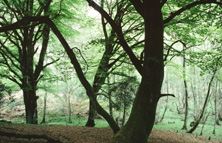|  Changes
in climate have affected the world, and the distribution and abundance
of its plants and animals, throughout time. However, during the
20th century, the rate of warming increased dramatically (significantly
exceeding any natural variations in climate over the last 1000 years).
This coincided with industrial and social development increasing
the concentration of greenhouse gases in the atmosphere and accelerating
what is essentially a natural process. ‘Global warming’
is being accompanied by changing precipitation patterns and increased
frequencies of extreme weather events, such as floods, droughts
and storms. Sea levels are also rising as ice sheets and glaciers
melt, and as sea water expands in response to higher temperatures. Changes
in climate have affected the world, and the distribution and abundance
of its plants and animals, throughout time. However, during the
20th century, the rate of warming increased dramatically (significantly
exceeding any natural variations in climate over the last 1000 years).
This coincided with industrial and social development increasing
the concentration of greenhouse gases in the atmosphere and accelerating
what is essentially a natural process. ‘Global warming’
is being accompanied by changing precipitation patterns and increased
frequencies of extreme weather events, such as floods, droughts
and storms. Sea levels are also rising as ice sheets and glaciers
melt, and as sea water expands in response to higher temperatures.
This trend is set to continue for at least the first half of the
21st century, even if a reduction in emissions of greenhouse gases
is achieved. It is expected that average global temperatures will
rise by between 1.4 and 5.8°C by 2100, depending on future levels
of greenhouse gas emissions.
 Climate
change presents a series of important and immediate challenges to
nature conservation. There is already clear evidence to show that
plants and animals, including those characteristic of the England’s
countryside and seas, are being affected by climate change. This
includes changes in populations, ranges, migration patterns, and
seasonal and reproductive behaviour of certain species. Such effects
will become more apparent and extensive as climate continues to
change, with local species extinctions and habitat-loss becoming
increasingly probable. Climate
change presents a series of important and immediate challenges to
nature conservation. There is already clear evidence to show that
plants and animals, including those characteristic of the England’s
countryside and seas, are being affected by climate change. This
includes changes in populations, ranges, migration patterns, and
seasonal and reproductive behaviour of certain species. Such effects
will become more apparent and extensive as climate continues to
change, with local species extinctions and habitat-loss becoming
increasingly probable.
A programme of scientific research is developing ‘tools’
to make predictions about the responses of species and their habitats
under possible future climates. Projects concerned both with terrestrial
and marine environments are underway:
 |
BRANCH
- Biodiversity Requires Adaptation in Northwest Europe under a CHanging climate (BRANCH is working in partnership across England, France and the Netherlands, to engage with planners to ensure that adaptation policies and actions for wildlife are embedded in spatial planning)
|
| |
 |
MONARCH
- Modelling Natural Resource Responses to Climate Change
(multi-partner project, with research led by the Environmental
Change Institute, Oxford)
|
| |
 |
MarClim - Marine Biodiversity and Climate Change (multi-partner
project, with research led by the Marine Biological Association,
Plymouth)
|
| |
 |
The role of nature conservation in mitigating the effects of
climate change (PhD studentship with the Tyndall Centre for Climate Change Research).
|
Outputs from these projects are providing the scientific basis
for a complementary policy programme. This is raising awareness
of climate change, and formulating advice and guidance on adapting
nature conservation policies and management practices to its impacts.
|

